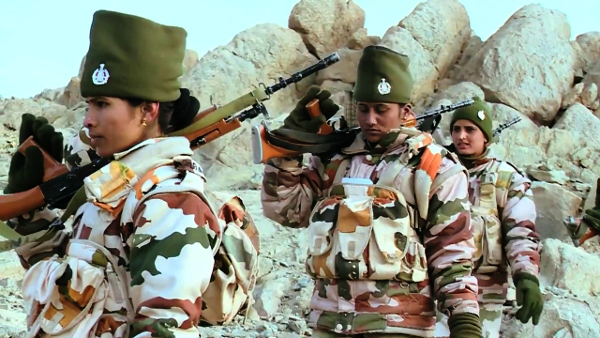India operationalised its strategic ITBP command in Jammu and Kashmir’s Leh-Ladakh district on Monday after moving it from Chandigarh as part of a plan to counter the ever-increasing Chinese military build up in the region.
The North West (NW) frontier of the Indo-Tibetan Border Police (ITBP), tasked to guard the 3,488-km long Sino-India border in peace times, is headed by an Inspector General (IG) of Police-rank officer, which is equivalent to a Major General in the Army.
“We are operational from the Ladakh region beginning April 1 and the force headquarters in Delhi has been informed,” ITBP IG Arvind Kumar told PTI from Leh.
The Indian tricolour and the force flag were unfurled to herald the new move and the frontier will be operating from the existing premises of the ITBP sector headquarter, another official said.
Sanctions have been received to create more buildings and logistics for the new command and Director General (DG) S S Deswal, the force chief, is expected to visit the formation soon.
PTI had first reported in January that the frontier has been ordered to move from its base in Chandigarh ‘lock, stock, and barrel’ to be operationalised at the new location from April 1. The distance between Chandigarh and Leh is 960 km.
Leh district in the mountains of Jammu and Kashmir is the base for the 14 Corps of the Army headed by a Lt General-rank officer and the new shift will allow a better interaction between the two forces “for strategic and defence planning”, the official operations blueprint had said.
The Army, which carved out a separate Corps in Leh after Jammu and Srinagar following the Kargil intrusion in 1999, has been demanding operational control over the ITBP, a proposal rejected by the government time and again.
Having the ITBP and the Army at the same combat location will resolve these issues as well, the sources had said.
“We have to be on the border and that is why the frontier is being sent to the forward area,” DG Deswal had earlier said.
The Union home ministry had first mooted the proposal for this strategic move in 2015 but it did not materialise owing to some “administrative reasons”.
As per the blueprint of deployment approved by the government for the ITBP, the Leh frontier of the border guarding force will have three sectors that will be based in Leh, Srinagar and Chandigarh and each of these will be headed by a Deputy IG-rank officer.
The location is expected to see a further upgrade of the forces’ command as it is expected that the proposed ITBP western command, headed by an Additional DG (equivalent to Lt Gen) rank officer, will be based here once the cadre restructuring of the force is cleared by the Union government.
The new ITBP frontier will have command of about a dozen battalions deployed along the Chinese border that runs along Jammu and Kashmir, official sources said, adding more battalions would be inducted in order to enhance the presence of the mountain-trained force on this icy, blizzard-prone mountainous border.
The ITBP has recently inducted a mechanised column of vehicles and communication equipment and all the weapons, artillery and combat paraphernalia that are being moved to Leh, that has both road and air connectivity.
The force also has sanctions to create and refurbish 40 Border Out Posts (BoPs) in these icy heights of Ladakh, where personnel have to face hostile weather as the mercury slips to as low as minus 40 degrees Celsius and the altitude ranges from 8,000-14,000 feet.
Modern ‘composite’ BoPs, which have weather control mechanism and facilities for better drinking water and rest and recuperation are being created for the ITBP troops in this region and they are expected to be in position by the next winters.
Leh, till now, had an ITBP sector establishment headed by a DIG-rank officer. The about-90,000-strong force not only guards the scenic Pangong lake in this area but also the upper reaches of the Himalayan mountain ranges that run across China.
As a part of plans to strengthen the military muscle along the China border, the government had similarly moved the North East (NE) frontier of the ITBP from Shillong in Meghalaya to Itanagar in Arunachal Pradesh in 2016.
Arunachal Pradesh and Leh regions have seen frequent incidents of incursions, standoffs and few instances of physical pushing and shoving between the troops of the Chinese PLA and the ITBP and the Army personnel over the last few years.
The 73 day-long military standoff between India and China in Dokalam (Sikkim) in 2017 is a grim reminder of these instances.
Sources have, however, said that 2018 saw an about 60 per cent decline in these incidents all along the eastern border front that the Indian states of Jammu and Kashmir, Himachal Pradesh, Uttarakhand, Sikkim and Arunachal Pradesh share with China.
Source:ET
Image Courtesy:ITBP
You may also like
-
IAF Aircraft Set Course For Exercise Eastern Bridge VII At Oman
-
IAF Set To Host The Indian Defence Aviation Exposition-II At Jodhpur
-
Defence Secretary to co-chair 5th India-Philippines Joint Defence Cooperation Committee meeting in Manila
-
Simultaneous Launch Of ‘malpe And Mulki’, Fourth And Fifth Ships Of Asw Swc (Csl) Project
-
Aatmanirbharta in Defence: MoD signs Contract with HAL for 240 AL-31FP Aero Engines for Su-30MKI Aircraft
